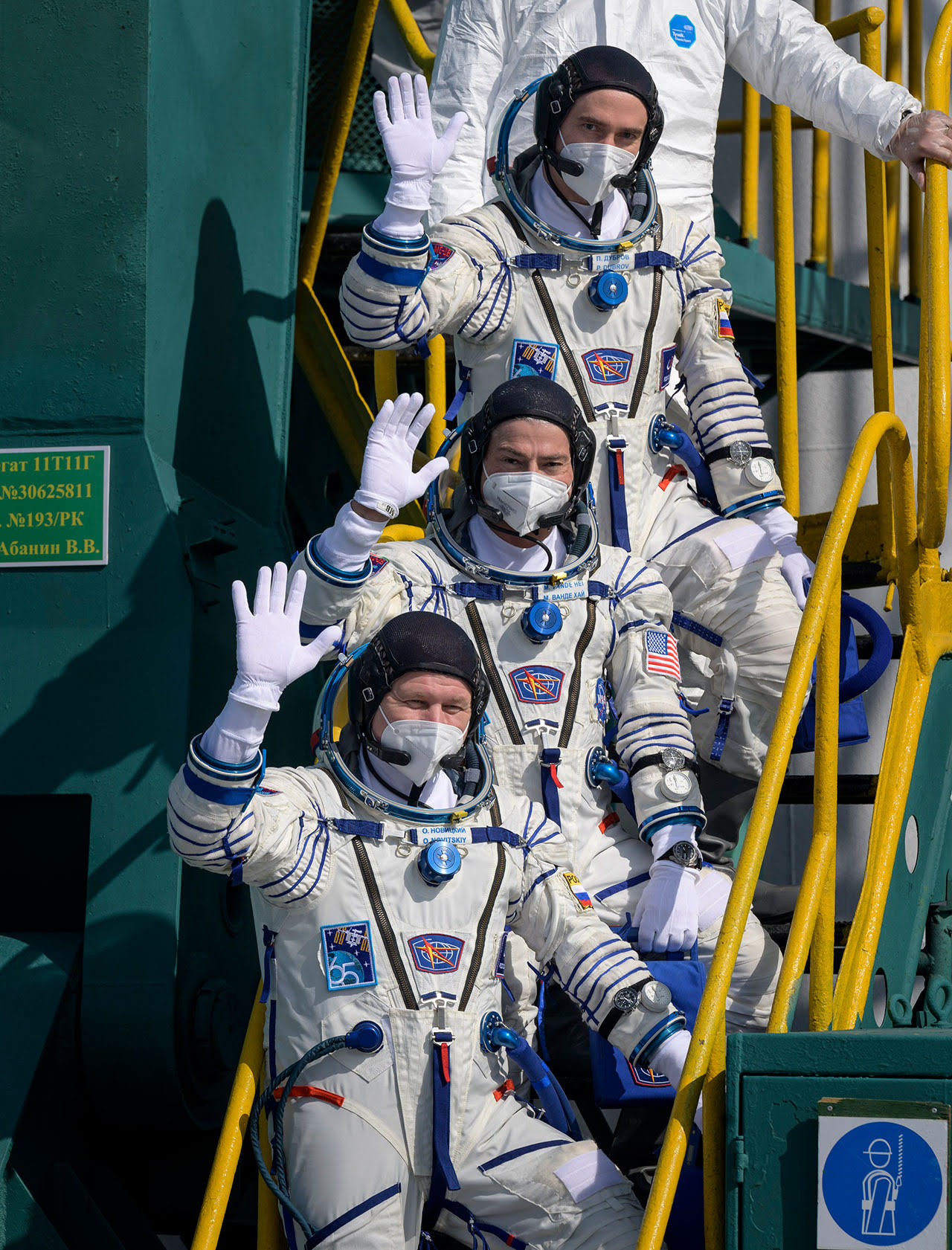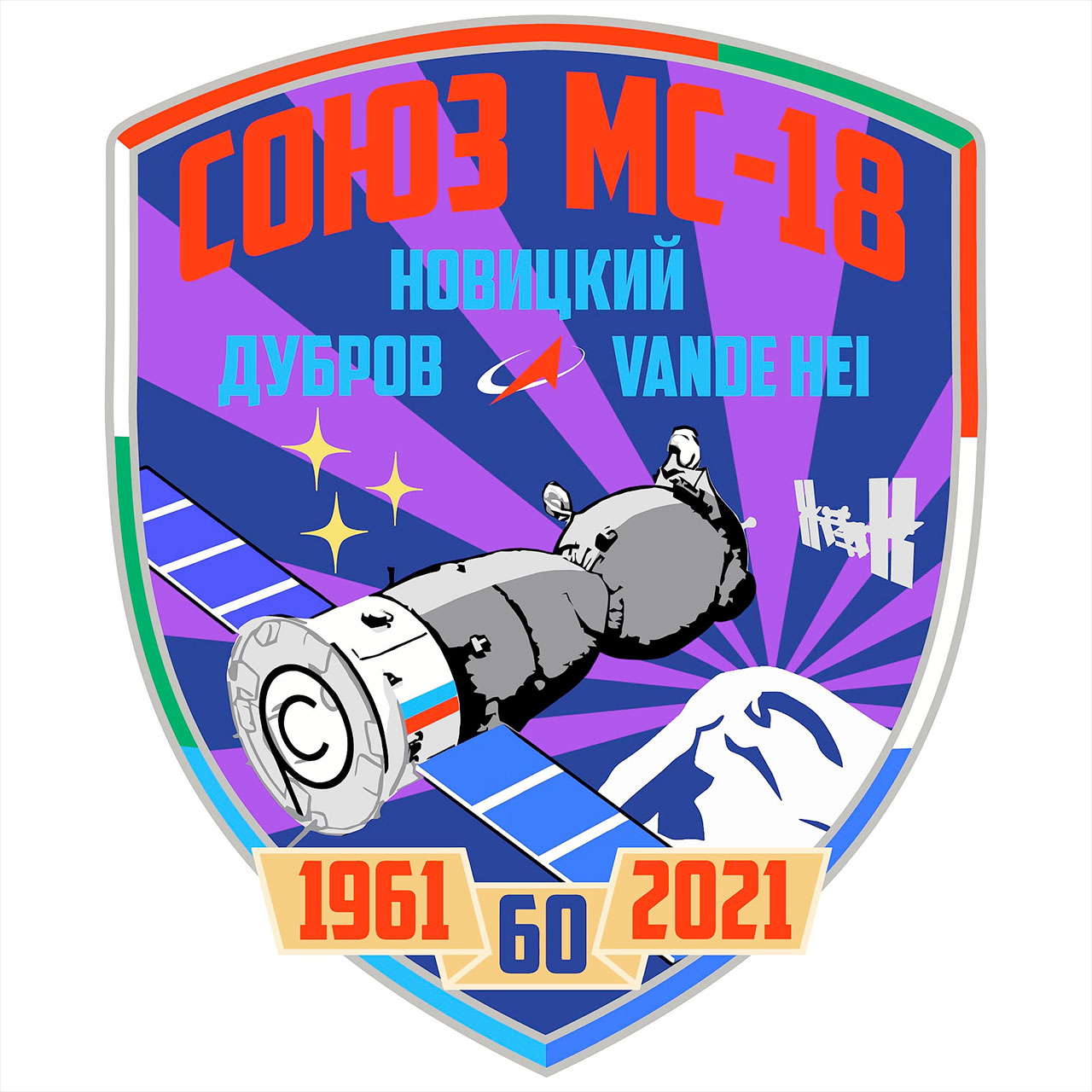Soyuz MS-18 crew launches to space station 60 years after first human spaceflight
The trio's Soyuz is named after Yuri Gagarin, the first person in space.
A three-person crew embarked for the International Space Station on Friday (April 9), launching just three days shy of the 60th anniversary of the first human spaceflight.
Cosmonauts Oleg Novitskiy and Pyotr Dubrov of Russia's state space corporation Roscosmos and NASA astronaut Mark Vande Hei lifted off aboard Russia's Soyuz MS-18 spacecraft for a three-hour, two-orbit rendezvous with the space station. The Soyuz took flight at 3:42 a.m. EDT (0742 GMT or 12:42 p.m. local time) from Site 31/6 at the Baikonur Cosmodrome in Kazakhstan, near where cosmonaut Yuri Gagarin made history by becoming the first person to fly into space on April 12, 1961.
To honor the anniversary, the Soyuz MS-18 spacecraft was christened the "Yu.A. Gagarin" and bore the name on its exterior insulation.
Infographic: How the first human spaceflight worked

"It is a big honor for us to fly and celebrate the anniversary of the first flight into space," said Novitskiy on Thursday (April 8), addressing the Russian state commission that approved the crew's launch.
"For me," added Dubrov, "it is a special honor to have my first flight on such an important date when we are celebrating the 60th anniversary of the first flight into space."
That the crew included an American underscored one of the key advancements made since Gagarin's one-orbit Vostok mission, said Vande Hei.
Get the Space.com Newsletter
Breaking space news, the latest updates on rocket launches, skywatching events and more!
"Of course, when we started, we were competing with each other and that was one of the reasons we were so successful at the beginning of human spaceflight," he said. "As time went on, we realized that by working together we could achieve even more, and that continues today, and I hope will continue into the future."

At present, Vande Hei is the last U.S. astronaut scheduled to fly on a Russian Soyuz, after 26 years of joint missions. Vande Hei's place on the Soyuz MS-18 mission came as the result of a barter between NASA, the U.S. space services company Axiom Space and Roscosmos.
It is expected that joint flights will resume once an agreement can be worked out for Russian cosmonauts to fly on U.S. commercial crew vehicles, including SpaceX's Crew Dragon and Boeing's Starliner spacecraft, but when that will occur is not yet known.
Novitskiy, Dubrov and Vande Hei arrived at the space station at 7:05 a.m. EDT (1105 GMT) on Friday, docking their Soyuz to Russia's Rassvet module. Their arrival will briefly increase the orbiting laboratory's complement to 10 crew members, including Expedition 64 commander Sergey Ryzhikov of Roscosmos and flight engineers Sergey Kud-Sverchkov also of Roscosmos, NASA astronauts Kate Rubins, Michael Hopkins, Victor Glover and Shannon Walker and Soichi Noguchi of the Japan Aerospace Exploration Agency (JAXA).
Soyuz spacecraft: Backbone of the Russian space program
Ryzhikov, Kud-Sverchkov and Rubins are scheduled to return to Earth aboard Soyuz MS-17 on April 16, beginning Expedition 65 aboard the station.
Hopkins, Glover, Walker and Noguchi are scheduled to depart aboard SpaceX's Crew Dragon "Resilience" on April 28, six days after the arrival of SpaceX's Crew-2 on the Dragon "Endeavour," which will carry up NASA astronauts Shane Kimbrough and Megan McArthur, Thomas Pesquet with the European Space Agency (ESA) and JAXA astronaut Aki Hoshide.
Novitskiy, Dubrov and Vande Hei are scheduled to stay aboard the space station through at least October. Dubrov and Vande Hei's stay may be extended out to a year depending on if Russia proceeds with its plans to launch a Russian filmmaker and an actress on a short-stay mission to film a movie aboard the space station in September. If the film crew launches, they will return to Earth with Novitskiy, filling Dubrov's and Vande Hei's seats aboard Soyuz MS-18.
"For me, it's just an opportunity for a new life experience," said Vande Hei in March when the prospect of the longer stay first became public. "I've never been in space longer than about six months, so if someone tells me I got to stay in space for a year, I'll find out what that feels like. I'm really enthusiastic about it."

Within their first six months together in space, Novitskiy, Dubrov and Vande Hei are expected to help perform over 260 experiments, with more than 40 taking place for the first time during Expedition 65. All three are also expected to conduct spacewalks for the purpose of extending the capabilities of the space station.
Vande Hei may assist with the installation of new solar arrays to increase the available power supply for expanded commercial activities on the orbital complex. Novitskiy and Dubrov are scheduled to prepare for and begin the integration of a new Russian multipurpose laboratory module, "Nauka," slated for launch in July.
The launch of Soyuz MS-18 marks Novitskiy's third mission to the space station, Vande Hei's second and Dubrov's first.
A 49-year-old former Russian Air Force pilot, Novitskiy previously served as a member of the Expedition 33/34 and Expedition 50/51 crews in 2012 and 2017, respectively, logging 340 days in space.
Dubrov, 43, was working as a software engineer when he was selected to train as a cosmonaut in 2012.
Vande Hei, 54, was previously a member of the space station's Expedition 53/54 crew in 2017. A retired colonel in the U.S. Army, he has already logged 168 days in space, including 26 hours and 42 minutes on four spacewalks.
Soyuz MS-18 "Yu.A. Gagarin" is Russia's 64th Soyuz spacecraft to launch for the International Space Station since 2000 and the 147th to fly since 1967.
Follow collectSPACE.com on Facebook and on Twitter at @collectSPACE. Copyright 2021 collectSPACE.com. All rights reserved.
Join our Space Forums to keep talking space on the latest missions, night sky and more! And if you have a news tip, correction or comment, let us know at: community@space.com.

Robert Pearlman is a space historian, journalist and the founder and editor of collectSPACE.com, a daily news publication and community devoted to space history with a particular focus on how and where space exploration intersects with pop culture. Pearlman is also a contributing writer for Space.com and co-author of "Space Stations: The Art, Science, and Reality of Working in Space” published by Smithsonian Books in 2018.In 2009, he was inducted into the U.S. Space Camp Hall of Fame in Huntsville, Alabama. In 2021, he was honored by the American Astronautical Society with the Ordway Award for Sustained Excellence in Spaceflight History. In 2023, the National Space Club Florida Committee recognized Pearlman with the Kolcum News and Communications Award for excellence in telling the space story along the Space Coast and throughout the world.









